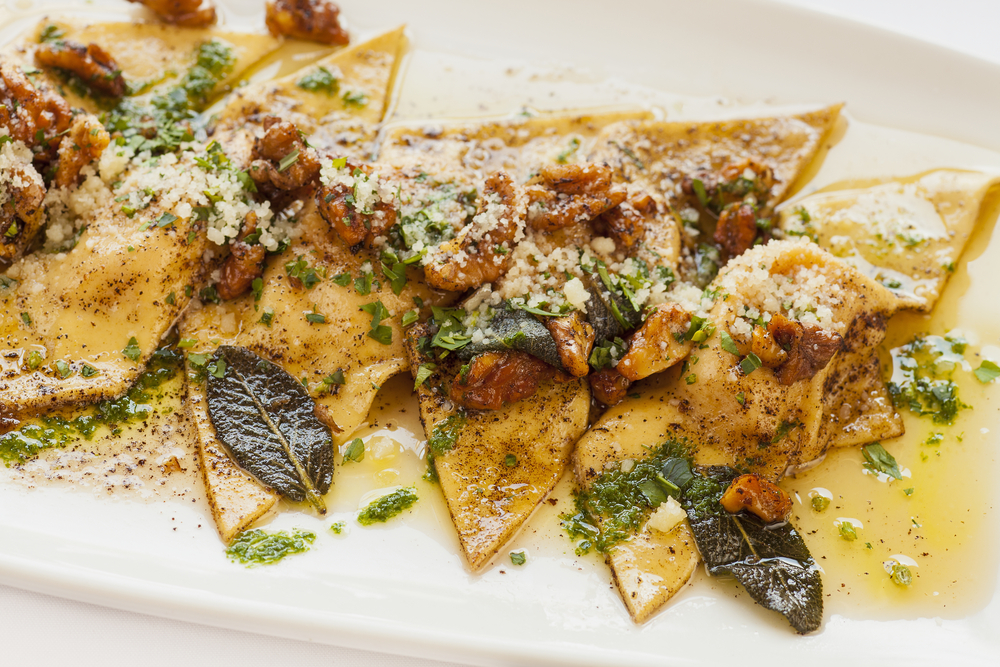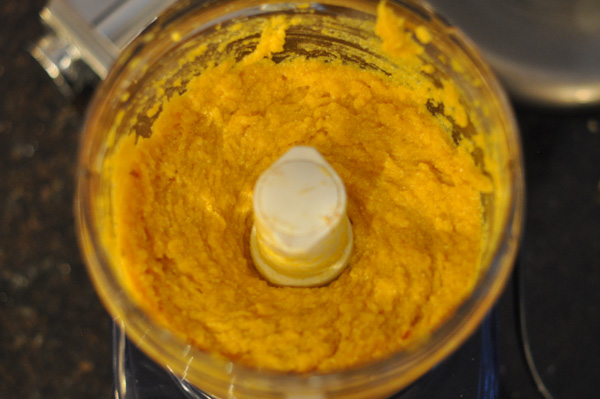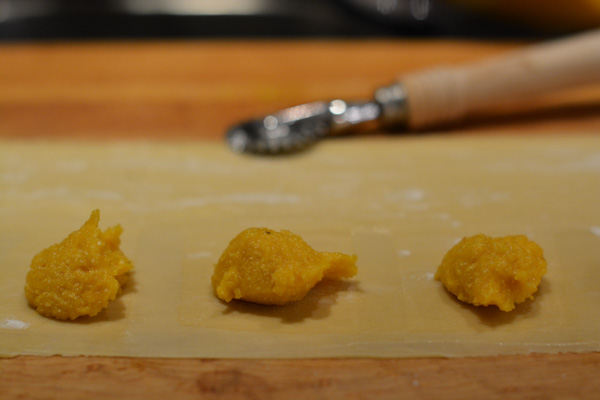Son Adam and I enjoy making pasta from scratch and have got it down to something of a smooth process. We don’t make it frequently enough for it to be completely glitch-free, but we manage pretty well. Since acquiring an Ankarscrum mixer, which is specifically designed for kneading bread and pasta dough, we’ve abandoned the entire “knead by hand” method. Downside: I am now forced to go to the gym for an upper-body workout!
We roll the dough to the desired thickness (#6 on the KitchenAid pasta roller) and make the ravioli by folding 10″ lengths of the dough lengthwise, dropping small balls of filling at 2″ intervals onto one side and cutting the ravioli by hand. That is much quicker than the ravioli attachment we tried a few years ago.
- The pumpkin filling
- Making the sage butter
- Making the ravioli
- Extra noodles
Last fall, I roasted a few pie pumpkins and froze the flesh in preparation for adventures such as these. We also enjoy a tagine made with roasted pumpkin, so demand now seems to be outstripping a fairly meagre supply. (Note to self – roast at least six next year).
This is the second time we’ve made pumpkin ravioli, adapted from a recipe from Williams Sonoma. Both times we’ve had more pasta than filling, so we put the cutting attachment onto the stand and turned the last bit of pasta into noodles for another use. We also noticed that the ravioli disintegrates into a soggy mess unless it is cooked or frozen immediately, likely due to the very moist nature of the filling.
Print
Pumpkin Ravioli with Sage Butter
This pumpkin ravioli recipe is served with a simple sauce of lightly browned butter and fresh sage, which heightens and contrasts with the sweetness of the pumpkin in the filling.
- Yield: Serves 4
Ingredients
For the Filling
- 454 g or 1 lb flesh from a roasted pie pumpkin or butternut squash
- 1 egg yolk, lightly beaten (freeze the white for another use)
- 30 g or 2 tbsp grated Parmigiano-Reggiano cheese, plus extra for serving
- ¼ tsp freshly grated nutmeg
- ¼ tsp fine sea salt
- 1 –2 tbsp dried bread crumbs
For the Pasta
- 575 g or 1¼ lb fresh pasta
For the Sage Butter
- 70 g or 2½ oz unsalted butter, clarified
- 12 large fresh sage leaves
- 35 g or 1/4 c pine nuts, lightly toasted
Instructions
Make the Filling
- Preheat the oven to 400ºF. Line a rimmed baking sheet with parchment paper.
- Cut the pumpkin(s) in half and remove the strings and seeds. Place cut side down on the parchment paper and roast until tender when pierced with the tip of a knife (45– 50 minutes). Let cool, then scrape the flesh from the peel. Measure the amount you will need for the recipe; transfer to a food processor and process until smooth. The rest can be frozen for future use.
- In a medium bowl, thoroughly mix the pumpkin puree, egg yolk, cheese, nutmeg and sea salt. Incorporate sufficient bread crumbs to bind the ingredients into a cohesive mixture. Cover and set aside.
Make the clarified butter.
- In a small skillet over low heat, melt the butter. Skim off and discard the solids as they rise to the surface when the butter stops sizzling. Be careful not to let it get too dark; it should be golden in colour. Pass the clarified butter through a fine-mesh sieve lined with cheesecloth or a coffee filter to extract any remaining solids.
- Return the clarified butter to the skillet and add the sage leaves. Gently heat until the butter is saturated with the flavour of the sage (3 to 4 minutes). Remove from the heat and cover to keep warm.
Make the Ravioli
- Using a pasta machine or a floured rolling pin, roll out the pasta dough 1/32 inch thick (#6 on the Kitchen Aid pasta roller). Cut into sections approximately 5” wide and 10” long. Fold the pasta lengthwise to mark the centre. For square ravioli, place one tablespoon of filling in each of four equally spaced locations down one side of the piece of pasta. Using a small pastry brush, lightly brush the edges of the sections of pasta around the filling with water. Fold the pasta over on itself, press gently and cut the ravioli into four pieces using a pastry wheel. You can make eight triangles by placing offset spoons of pasta on both sides of one piece of pasta and covering it with another.
- Meanwhile, in a large, shallow skillet, bring 2” of salted water to a rapid boil. Gently drop about half of the ravioli and cover the skillet until it returns to a boil. . Uncover and cook, nudging the ravioli gently from time to time; reduce the heat as needed to prevent the ravioli from knocking against one another and breaking. (3–5 minutes total). Repeat with the remaining ravioli.
- Transfer the ravioli to a warmed, large serving bowl with the aid of a large slotted spoon. Allow a little water to cling to the pasta, so they remain moist. Drizzle some sage butter over the ravioli, sprinkle with the pine nuts and serve immediately.
Notes
Tip: To test for doneness, remove a single raviolo and snip off a corner; if the pasta looks cooked through and tastes tender, it’s done.
Adapted from Williams-Sonoma The Pasta Book, by Julia della Croce (Weldon Owen, 2010).






